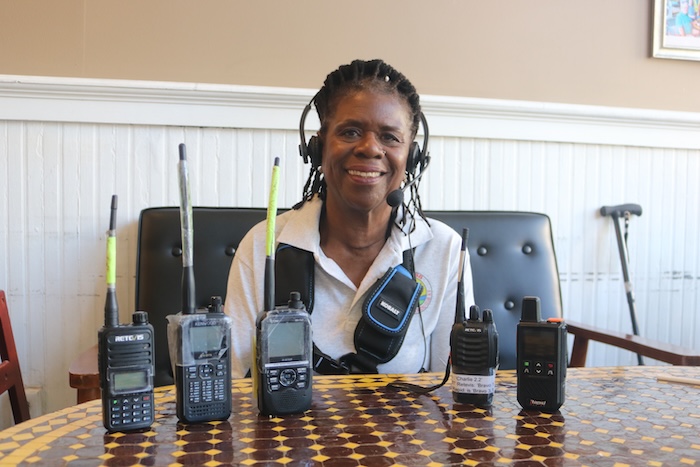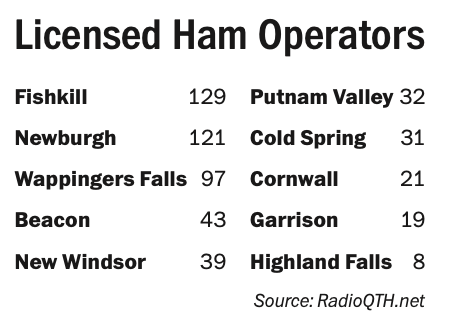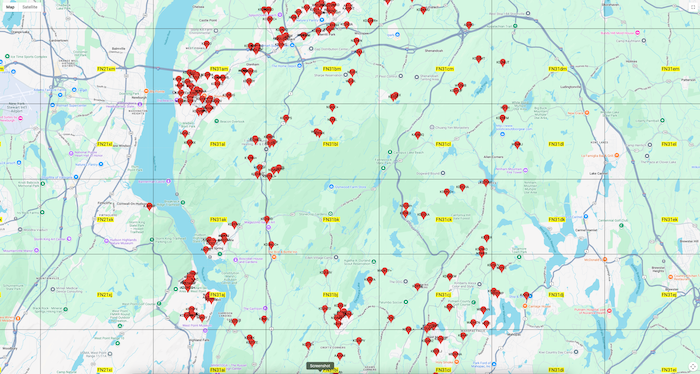A hobby — but also disaster response
It wasn’t marked by parades, fireworks or an interview on 60 Minutes, but World Amateur Radio Day was April 18.
For many, amateur, or “ham” radio, is viewed as a hobby from the past. But it’s very much alive and more than a pastime, locally and internationally.
The century-old International Amateur Radio Union estimates there are 3 million operators in 160 countries, including 700,000 in the U.S., 540 in the immediate area, 50 in Philipstown and 43 in Beacon.
For many, interest in ham radio began early in life. As a 10-year-old, Joe Barbaro of Cold Spring loved listening to English-language, shortwave broadcasts from Germany, Russia and other faraway countries. “Radio Moscow was a favorite,” he said. “Even at a young age I knew they were full of it, but it was fun to listen to.”
He graduated to ham radio at age 14. “England was about the best I could do” for conversations, he said. “I didn’t have powerful enough equipment for beyond that,” he said. “I was kind of a minor-leaguer.”
Another Cold Spring resident, Damian McDonald, got started at age 6. “My uncle was a Franciscan priest based in Bolivia, and the only way we communicated was ham radio,” he said. “It was kind of magical, even with the static.”
It motivated him to build his own ham radio from a Heathkit; today he has a mobile ham station in his car. Before he retired from a career in cybersecurity, he enjoyed conversations with other operators during his daily commute to New Jersey. “I could hold a conversation with the same person all the way down,” he recalled.

McDonald noted that “emergency preparedness is still a core tenant of amateur radio,” and Anesta Vannoy of Beacon would agree. She got into ham radio in 2018 as a disaster response chaplain. She wanted to assist at emergencies but, as a senior citizen, thought it could be difficult getting to the scenes of incidents.
She belongs to four networks: Westchester Emergency Communications Association, Mount Beacon Amateur Radio Club, Orange County Amateur Radio Club and the Harlem Emergency Network. “I like that I’m preparing myself to help others,” she said.
She hones her skills at events such as the New York Airshow at Orange County Airport and the St. Patrick’s Day parade in Wappingers Falls. She also attends trainings led by “elmers” from her networks — lingo for more experienced operators. Part of her weekly routine is checking her five radios to ensure each is charged and operational.
Her son, Raheem, will soon take the entry-level test for licensing by the Federal Communications Commission. Operators must pass tests at progressive levels: Technician, General and Amateur Extra.
Raheem is relearning Morse Code, a skill he acquired as a Boy Scout. Although Morse Code is no longer required, “it can still be useful in certain emergency situations,” he said.

First responders see ham radio as an asset. Ralph Falloon, a Philipstown resident who is deputy commissioner of the Putnam Bureau of Emergency Services, said operators are considered part of the county’s emergency preparedness network and provide vital backup in situations such as interruptions to the power grid.
“The Putnam Emergency and Amateur Repeater League, or PEARL, has an office in our building,” in Carmel, he said. “They have radio equipment here and mobile towers they can set up for mini-networks.”
Robert Cuomo, Putnam’s director of emergency medical services, offered an example: If the grid goes down and a hospital generator fails, ham operators could set up on site and communicate with ambulances. That’s what happened in 2005 in New Orleans when the region’s infrastructure was devastated by Hurricane Katrina. “In many cases, the only communication in and out was ham radio,” he said.

PEARL hosts field days for operators. It includes contests to see who can speak to the most people around the world[ but also covers disaster training, Cuomo said. “They can’t use commercial power — just a battery or generator. They throw antennas up in trees or bring in portable towers.”
There are four basic types of ham radios. Handheld transceivers, the most common, have a range of a few miles but, when used through a repeater station such as one atop Mount Beacon, can achieve global reach; mobile stations that are typically installed in vehicles; base stations in fixed locations such as inside a home; and portable stations that are useful for emergencies and field operations.
The term “ham” dates to the turn of the 20th century; it was not a compliment. Professional radiotelegraph operators referred to amateurs as “hams” or “plugs.” The first amateur radio satellite was launched in 1961, and more than 100 have followed.

